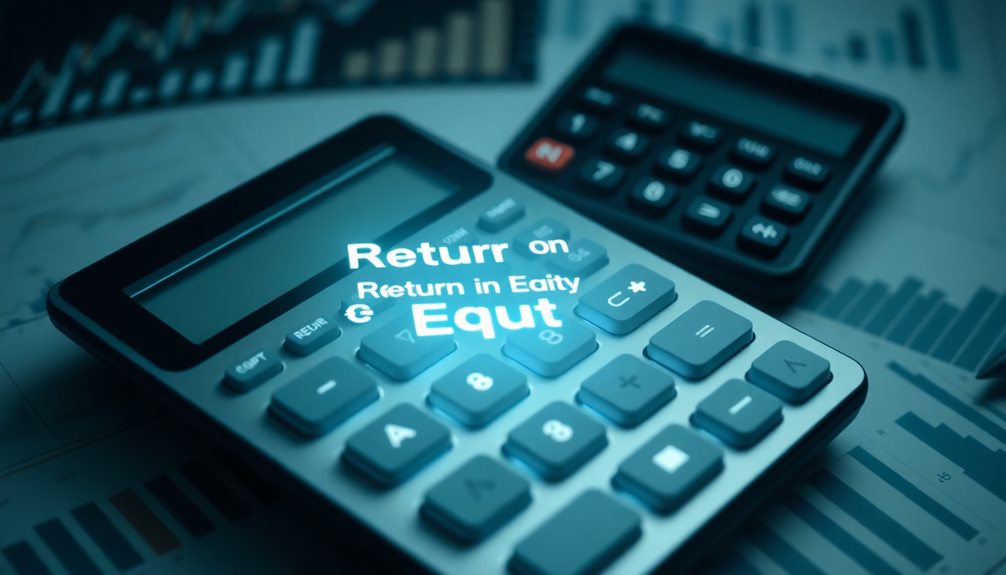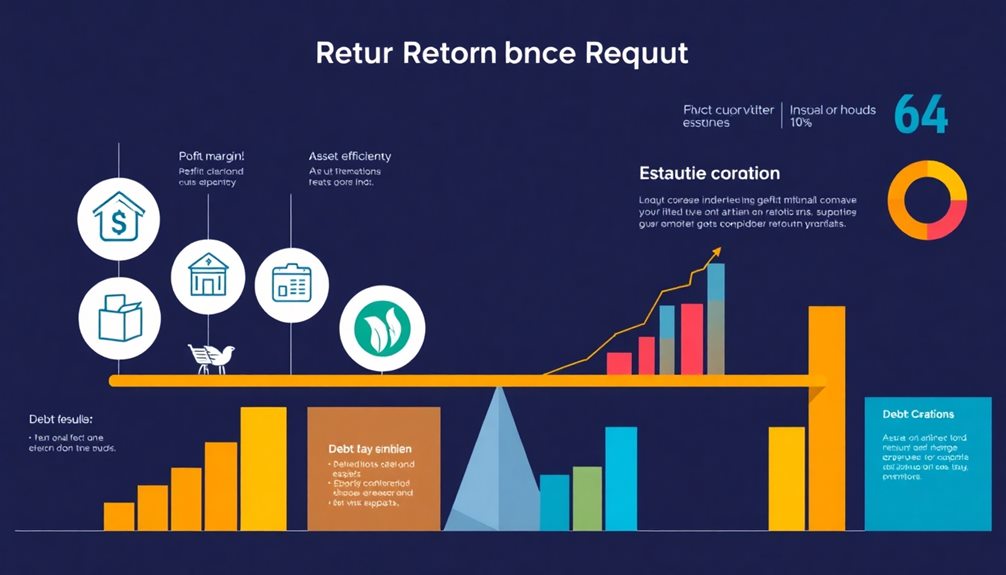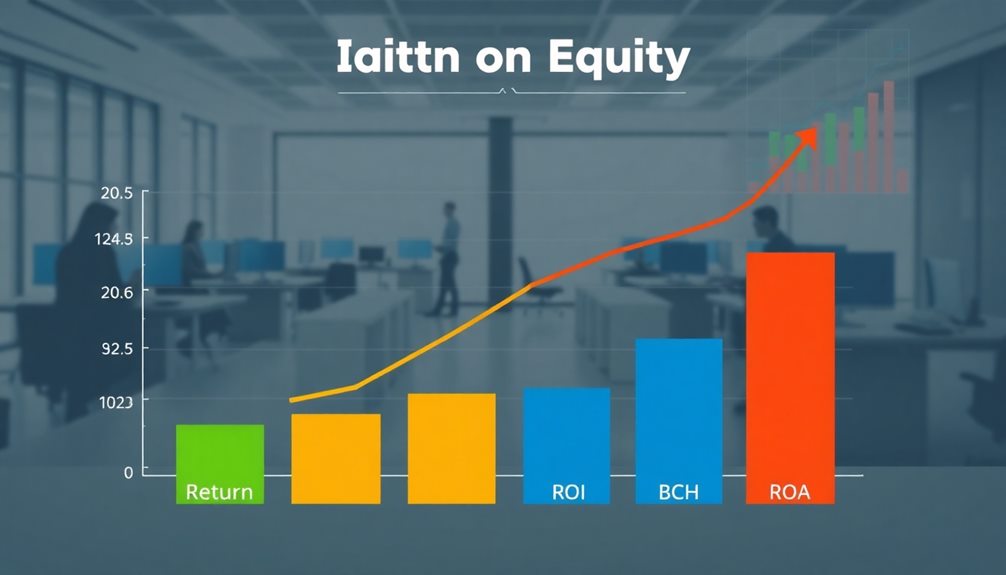Return on equity (ROE) measures a company's profitability relative to shareholders' equity. To calculate it, you divide net income by average shareholders' equity. A strong ROE usually falls between 15% and 20%, signaling effective management. Comparing your company's ROE against industry benchmarks helps you gauge financial performance accurately. Keep in mind that industry variations exist; technology firms often boast higher ROE than capital-intensive sectors. While ROE is vital for evaluating financial health, it's important to take into account factors like profit margins and asset turnover. You'll discover how to enhance ROE with targeted strategies to improve overall financial health.
Key Takeaways
- Return on Equity (ROE) calculates a company's profitability by dividing net income by average shareholders' equity, providing insight into financial success.
- A high ROE (15%-20%) indicates strong financial performance, with technology firms often exceeding 18% compared to capital-intensive sectors below 10%.
- Using average shareholders' equity ensures a more accurate assessment of financial performance by smoothing out fluctuations from share buybacks or new equity issuance.
- ROE serves as a key indicator for investors, with solid figures suggesting management efficiency and growth potential, particularly when above the S&P 500 average of 21.71%.
- Industry variations in ROE highlight the need for benchmark comparisons, as high ROE in one sector may not translate to success in another.
What Is Return on Equity?

Return on Equity (ROE) is an essential financial metric that helps you gauge a company's profitability by measuring how effectively it uses shareholders' equity to generate profits. You can calculate ROE by dividing net income by average shareholders' equity. A high ROE, typically between 15% to 20%, indicates strong financial performance and efficient management of equity financing. Conversely, an ROE below 10% is generally considered poor.
As of Q2 2024, the average ROE for S&P 500 companies stands at around 21.71%, serving as a benchmark for effective equity management in the U.S. market.
However, it's important to conduct an industry comparison when evaluating ROE, as normal benchmarks vary widely across sectors. For instance, technology firms often boast an ROE exceeding 18%, while capital-intensive industries, like utilities, may exhibit ROEs below 10%.
Calculating Return on Equity

To calculate Return on Equity (ROE), you'll use the formula ROE = Net Income / Average Shareholders' Equity.
Understanding the importance of average equity is essential, as it smooths out fluctuations and provides a clearer picture of financial performance.
ROE Formula Explained
Understanding the ROE formula is essential for evaluating a company's profitability in relation to shareholder investment. The formula for calculating Return on Equity (ROE) is straightforward:
| Component | Description |
|---|---|
| Net Income | The profit a company earns after all expenses. |
| Average Shareholders' Equity | The mean equity over a period, calculated as (Beginning Equity + Ending Equity) / 2. |
To calculate ROE, you use the formula: ROE = Net Income / Average Shareholders' Equity. This calculation methodology guarantees you get an accurate assessment of a company's financial health. A higher ROE reflects effective management of shareholder equity, signaling strong profitability.
Typically, an acceptable ROE falls between 15% and 20%, though this can vary by industry. Additionally, you can derive ROE using the dividend growth rate divided by the earnings retention rate, showcasing how profits are reinvested. By understanding these concepts, you can better gauge a company's performance and its ability to generate returns for its shareholders.
Importance of Average Equity
When calculating Return on Equity (ROE), using average equity is key for obtaining a more accurate picture of a company's financial performance. Average equity is derived by adding the beginning and ending shareholders' equity for a specific period and dividing by two. This method helps you account for fluctuations in equity, such as share buybacks or new equity issuance, which can distort the assessment of a company's profitability.
By calculating ROE with average equity, you gain a clearer understanding of how effectively a company uses the equity invested by shareholders. This leads to better investment decisions, as it reflects the true profitability of the business relative to its equity base.
Consistently utilizing average equity in your ROE calculations also enhances comparability across different periods, making financial analysis more robust, particularly when evaluating trends in company performance. Analysts often prefer this approach, as it mitigates the impact of seasonal variations in net income and equity, providing a more reliable picture of the company's financial health.
To summarize, average equity is essential for accurate ROE calculations, allowing you to make informed assessments of a company's success over time.
Interpreting ROE Results

When you look at ROE, it's essential to compare it against industry benchmarks to understand its significance.
A strong ROE can indicate effective management, but remember that variations across sectors can skew your interpretation.
Focusing on these comparisons helps you gauge a company's performance more accurately.
ROE Benchmarks and Comparisons
Analyzing ROE benchmarks provides valuable insight into a company's financial health and management effectiveness. To gauge your company's Return on Equity (ROE), compare it against the industry average. For instance, as of Q2 2024, the average ROE for S&P 500 companies is about 21.71%. A solid ROE typically falls between 15% to 20%, while an excellent ROE is around 40%.
Industries vary markedly; capital-intensive sectors like utilities may report lower ROE (10% or less), whereas technology firms often exceed 18%. By comparing your company's ROE to its industry peers, you can identify competitive advantages and assess management efficiency. Additionally, consistent evaluation of historical ROE trends within the same industry can reveal insights into potential investment risks or opportunities.
Here's a quick reference table:
| ROE Category | Percentage Range | Industry Examples |
|---|---|---|
| Solid ROE | 15% – 20% | Utilities, Retail |
| Excellent ROE | 40%+ | Technology, Finance |
| Below Average ROE | 10% or less | Capital-Intensive Sectors |
Understanding these benchmarks is essential for achieving financial success.
Analyzing Industry Variations
Understanding industry variations in Return on Equity (ROE) is vital for making informed investment decisions. ROE benchmarks can differ dramatically across sectors. For instance, technology firms often achieve ROEs above 18%, while utilities typically maintain ROEs of 10% or less.
In capital-intensive industries, a high ROE may signal effective asset utilization, yet these figures tend to be lower due to considerable investments in fixed assets. Consumer goods companies usually showcase stable ROE figures, reflecting their consistent demand and operational efficiency.
When you compare a company's ROE to its industry average, you can gain valuable insights into its competitive advantages. An ROE notably above the average suggests superior management and profitability.
However, it's important to take into account the context of ROE within its industry. Industries with varying operating margins can lead to misleading interpretations if ROE is analyzed in isolation.
Always remember that financial health isn't solely about high ROE; understanding the underlying factors and industry norms will help you make more accurate assessments of a company's performance. This nuanced approach guarantees you won't overlook vital details that could impact your investment decisions.
Importance of ROE in Investing

Return on Equity (ROE) serves as an essential gauge in evaluating a company's financial health and investment potential. When you look at ROE, you're examining how well a company generates profit from each dollar of shareholders' equity. A solid ROE, typically between 15% and 20%, can indicate strong profitability and effective management efficiency.
Investors often seek companies with an ROE above the S&P 500's long-term average of around 21.71%. Such figures signal potential for robust financial performance and future growth. Maintaining or increasing ROE over time suggests that a company possesses sustainable competitive advantages and effective reinvestment strategies, both vital for achieving long-term investment success.
Moreover, comparing ROE across industry peers provides valuable insights into a firm's operational efficiency and profitability. This comparative analysis aids in informed stock selection, allowing you to identify businesses that outperform their competitors.
Factors Influencing Return on Equity

When evaluating a company's Return on Equity (ROE), several key factors come into play that can greatly influence its value. Understanding these factors helps you assess a company's financial health more accurately.
| Factor | Description |
|---|---|
| Net Profit Margin | Measures profit from revenue, impacting ROE's numerator. |
| Asset Turnover | Indicates asset efficiency in generating sales, affecting profitability. |
| Financial Leverage | Higher debt can amplify ROE but increases risk and volatility. |
| Retention Ratio | Represents earnings retained for growth, influencing equity growth rate. |
| Industry Variations | Differences in capital intensity and profit margins affect acceptable ROE benchmarks. |
Each of these factors plays a vital role in shaping a company's profitability and overall financial performance. For instance, a high net profit margin enhances ROE, while effective asset turnover boosts sales generation. Additionally, financial leverage can increase returns but also elevate risk. The retention ratio impacts the growth rate of shareholders' equity, further influencing ROE. Finally, keep in mind that industry variations can lead to different expectations for ROE, as capital-intensive sectors may yield lower benchmarks compared to tech firms.
Risks Associated With High ROE

While high Return on Equity (ROE) often signifies a company's impressive financial performance, it can also conceal significant risks. Companies boasting extremely high ROE figures, especially those above 40%, may rely on excessive debt or high leverage, which increases financial risk and undermines long-term sustainability.
When a firm uses debt to boost its ROE, it can create an illusion of profitability, masking underlying issues.
Volatility in net income can further complicate the picture. If a company's ROE is fluctuating, it may indicate challenges in capital reinvestment decisions or operational efficiency. This inconsistency can lead to investor caution, as stakeholders might question the company's ability to maintain its performance.
Moreover, comparing ROE across different industries can be misleading. Capital-intensive sectors typically exhibit lower ROE benchmarks, making it essential to evaluate industry context.
A high ROE in one sector may not reflect the same level of success as in another. Consequently, while ROE can serve as a useful metric, it's important to dig deeper and assess the risks behind those numbers to avoid misjudging a company's true financial health.
Limitations of ROE Analysis

Despite its popularity, ROE analysis has considerable limitations that can skew your understanding of a company's true performance. For instance, when companies engage in share buybacks, they reduce shareholders' equity, which can artificially inflate ROE without improving the underlying business performance.
Additionally, high levels of debt can distort ROE figures, creating an inflated perception of profitability while masking the financial risks tied to increased leverage.
You should also be aware that variations in how ROE is calculated—whether using beginning, ending, or average equity—can lead to inconsistent comparisons and misleading interpretations over different time periods or among companies.
Moreover, ROE doesn't provide a complete picture of a company's financial health; it often overlooks key factors like cash flow and operational efficiency that greatly impact overall performance.
Comparing ROE across different industries is particularly tricky, as varying capital structures and profit margins can lead to misleading comparisons. To make accurate assessments, it's crucial to use industry-specific benchmarks.
Comparing ROE to Other Metrics

Understanding the limitations of ROE can help you better evaluate a company's financial performance by comparing it to other key metrics. Return on Equity (ROE) focuses specifically on net income relative to shareholders' equity, giving insight into how well a company uses its equity to generate profits.
However, it's crucial to contemplate Return on Assets (ROA), which measures profitability based on total assets, highlighting different efficiency aspects.
You might also look at Return on Capital Employed (ROCE), which evaluates how effectively a company generates profit from all capital sources, including debt. By comparing ROE with ROCE, you can gain a clearer picture of profit generation from total capital.
Additionally, pairing ROE with profit margins can enhance your understanding of a company's overall efficiency and management effectiveness, as high ROE often indicates strong net profit margins.
Don't forget to reflect on industry averages for ROE, as they can vary widely. For example, technology firms often achieve ROE above 20%, while capital-intensive industries like utilities might average closer to 10%.
Contextual comparisons are crucial for accurate evaluations of a company's financial metrics.
Enhancing ROE Through Management Strategies

One way to boost Return on Equity (ROE) is by implementing targeted management strategies that focus on enhancing profitability and efficiency.
To start, you can improve net income by adopting cost reduction strategies and operational efficiencies, which directly elevate your profit margins. Additionally, optimizing your capital structure with a balanced mix of debt and equity can amplify returns without notably increasing financial risk, further improving ROE.
Next, pay attention to asset management to enhance asset turnover. Efficiently using resources leads to higher sales per dollar of assets, positively impacting your ROE.
You might also consider strategic reinvestment of retained earnings into high-return projects. By increasing your retention ratio while maintaining or growing ROE, you can notably boost your Sustainable Growth Rate (SGR).
Frequently Asked Questions
How Do You Know if Return on Equity Is Good?
To determine if return on equity is good, compare it with industry averages and historical trends. Generally, an ROE above 15% indicates strong performance, while below 10% suggests potential inefficiencies you should investigate.
What Does a 20% ROE Mean?
A 20% ROE means you're generating $0.20 of profit for every dollar invested by shareholders. It shows effective management, efficient capital use, and suggests strong potential for dividends and reinvestment opportunities. Investors usually favor this performance.
Is Return on Equity a Measure of Profitability?
Think of return on equity as a financial compass. Yes, it's a measure of profitability, showing how well a company turns investments into profits. A higher ROE indicates stronger financial health and effective management.
What Does It Mean When ROE Is Over 100%?
When ROE exceeds 100%, it means the company's generating over double its shareholders' equity in profits. This suggests exceptional profitability but may also indicate risks like over-leverage or unsustainable profit margins that require careful evaluation.
Conclusion
To summarize, understanding Return on Equity (ROE) can truly elevate your investment decisions. Did you know that companies with an ROE above 15% are often viewed as financially healthy? By measuring this key metric, you can gain insights into a company's profitability and efficiency. However, it's crucial to reflect on the bigger picture, including risks and limitations. Ultimately, by enhancing ROE through effective management strategies, you can position your investments for greater success.










